
Cosmic Collision:
This is a painting of four real galaxies that will smash together in about a hundred million years. The four galaxies piled together will make one of the biggest galaxies in the universe!
Slyder Images
Here are larger versions of the images in the Slyder puzzles, along with their captions and credits.

Cosmic Collision:
This is a painting of four real galaxies that will smash together in about a hundred million years. The four galaxies piled together will make one of the biggest galaxies in the universe!

Trailing Earth:
The Spitzer Space Telescope orbits the Sun just like Earth does. But Spitzer circles the Sun behind Earth by more than 50 million miles.

Brown dwarf:
This painting shows a not-quite-star called a brown dwarf. It is in the center of a disk of gas and dust that could someday form planets. The brown dwarf is too big to be a planet, but too small to become a star.
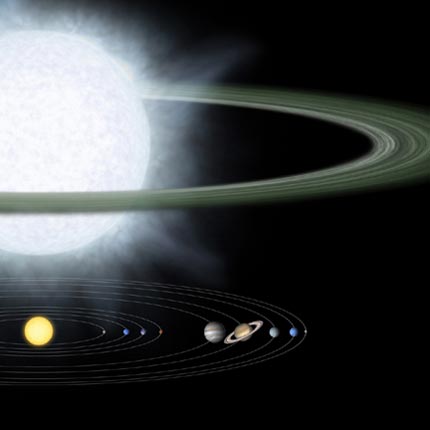
Hypergiant star:
This painting shows a newly discovered gigantic blue star. Planets could be forming from the dust and gas that surrounds it. Our own sun and solar system drawn at the bottom shows just how big this star could be!
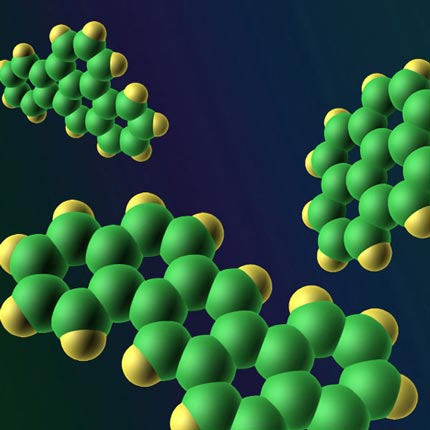
Smog in space:
The Spitzer Space Telescope has found molecules like this in space. They are like the greasy black junk on barbecue grills. (Green are carbon atoms, yellow are hydrogen atoms.)
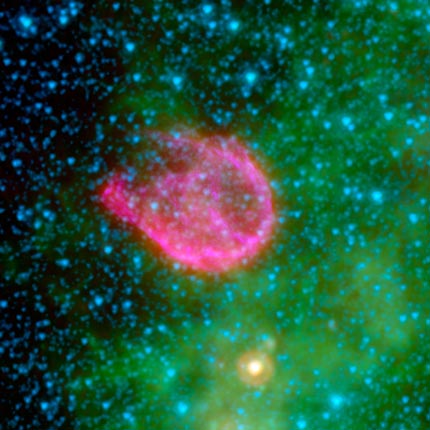
Blast from the past:
This is the gas cloud left from a supernova—the explosion of a giant star—a few thousand years ago. This remnant is called N132D. The Spitzer Space Telescope made this image.
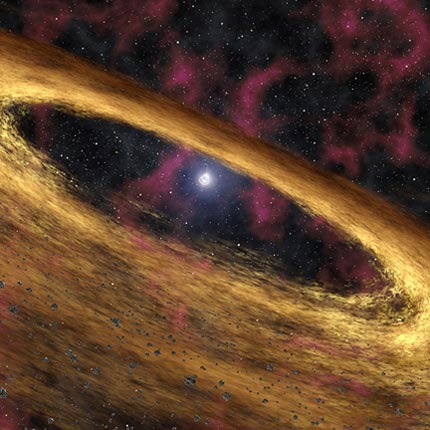
Pulsar:
This artwork shows a pulsar surrounded by a dusty disk with rocky planets. The pulsar is the tiny, hot, dense core of a giant star that exploded millions of years ago in a supernova. The dust (and maybe planets) is the leftover debris.
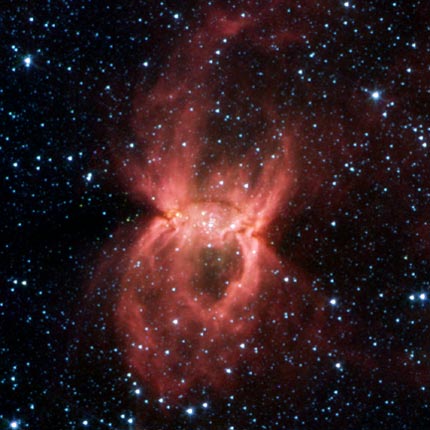
Black Widow:
The Spitzer Space Telescope observed this spider-shaped cloud of dust and gas. Spitzer sees infrared light that our eyes can't see. It can see through gas clouds like this to reveal that new stars are forming inside them.
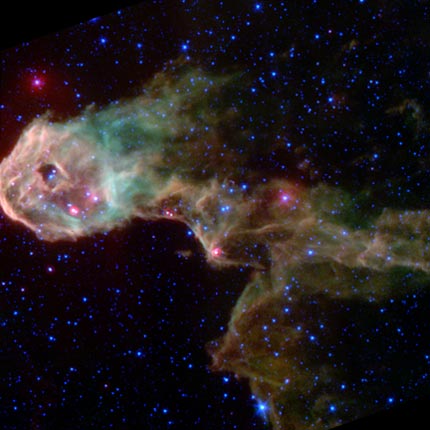
Elephant's Trunk:
This nebula (cloud of gas and dust in space) is a glowing star nursery. The Spitzer Space Telescope took this image in infrared light, which shines through the dust cloud to reveal the new stars being born inside it.

Star-forming Fingers:
This beautiful, glowing cloud of dust is called the Eta Carinae Nebula. This image from Spitzer in infrared light shows new stars forming in the finger-like pillars of dust.
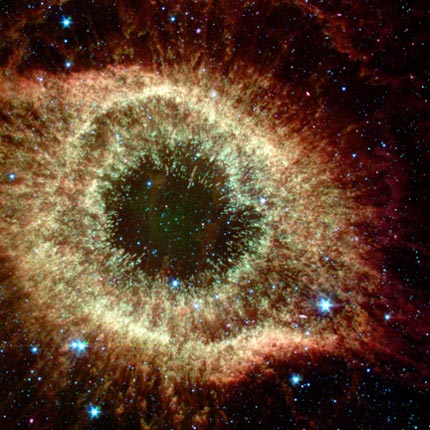
Cosmic eye:
This eye-like cloud of gas is called the Helix Nebula. A star reached the end of its life, blew off most of its material, and this is what is left. The star itself is now a tiny "white dwarf" in the center of the image.
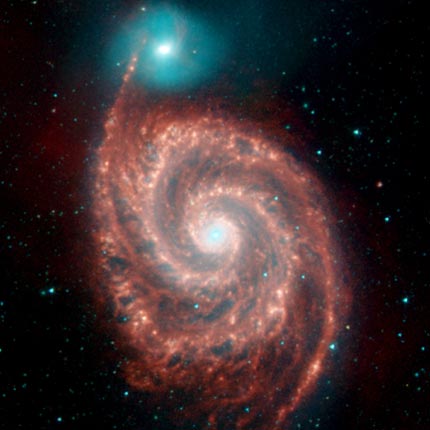
Whirlpool:
This is the Whirlpool Galaxy in infrared light. The red and orange show places where dust and gas are making new stars. The smaller companion galaxy at the top appears blue, indicating older stars.
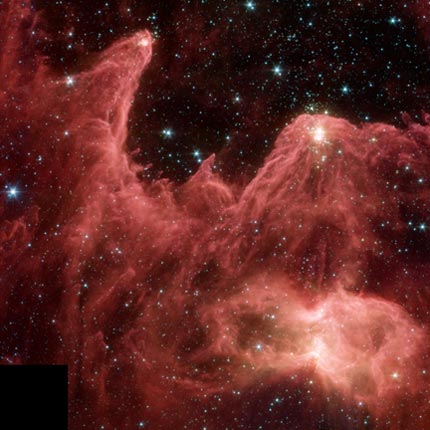
Mountains of Creation:
Inside these beautiful mountains and pillars of glowing dust, new stars are being born. This dust glows in infrared light, which our eyes cannot see, but the Spitzer Space Telescope can.
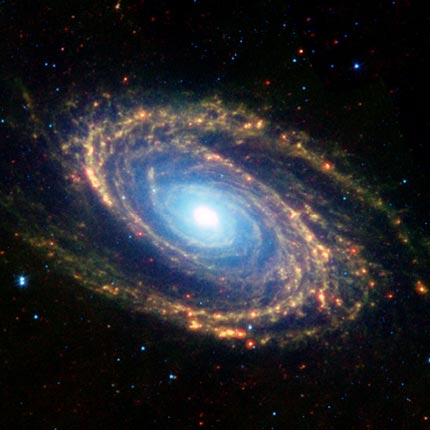
Around she goes:
Galaxy M81 has long, spiral arms. They do not show up in images made with ordinary light. This Spitzer image shows them clearly though because they glow in infrared light, which Spitzer's telescope can see.

Explosion!
This beautiful cloud, called the Trifid Nebula, was formed when a massive star exploded in a supernova. Lots of new stars are forming from the leftover supernova gas and dust.
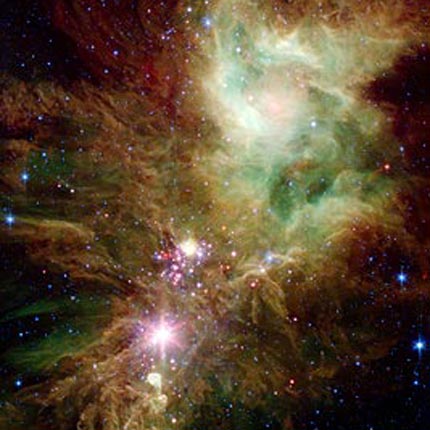
Christmas Tree:
Turn the picture upside-down, and the Christmas Tree Cluster will look like its name. The pink and red specks in this Spitzer image are infant stars (only about 100,000 years old).
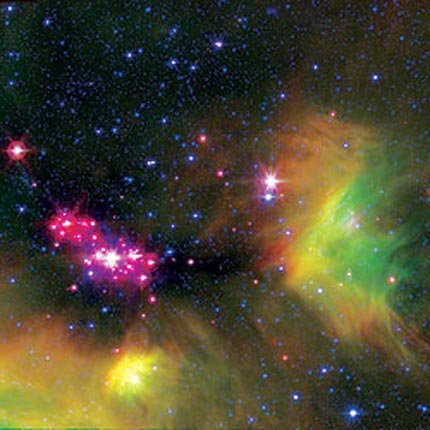
Pink babies:
Infant stars look pink in this Spitzer Space Telescope image taken in infrared light—a kind of light we cannot see with our eyes. The blue specks are older stars that shine through the gas and dust cloud.
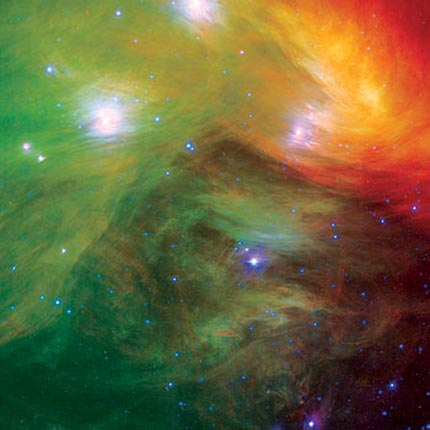
Seven Sisters:
This Spitzer image shows some of the young stars in the Pleiades [PLEE-a-dees] group. It is also called the Seven Sisters, but there are more than seven stars in the group.

Rosebud:
Reflection Nebula NGC 7129 looks like a Valentine's Day rose. This Spitzer image was made with infrared light. This cloud of dust and gas is home to about 130 baby stars.
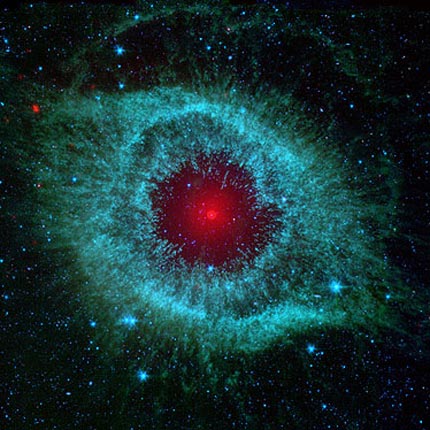
Here's looking at you:
The Helix Nebula is very eye-like in infrared light. It is a cloud of gas and dust blown off a star like our Sun at the end of its life. In the center is the tiny white dwarf star that is left.

Eagle Nebula:
New stars are forming inside this vast and stormy cloud of gas and dust. The finger-like parts of the nebula are far bigger than our entire solar system!
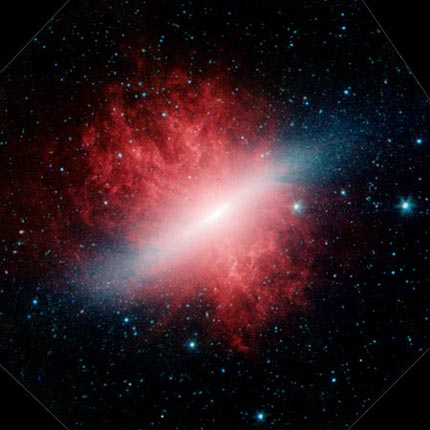
Galaxy on fire?
In visible light, pictures of this galaxy, M82, do not show these huge clouds of dust above and below it. The dust glows in infrared light, so Spitzer can see it and also detect sooty particles as in car exhaust.

Cosmic fireworks:
This is what is left of a star called Cassiopeia A. It exploded and its remains glow in infrared light, which the Spitzer Space Telescope can see.
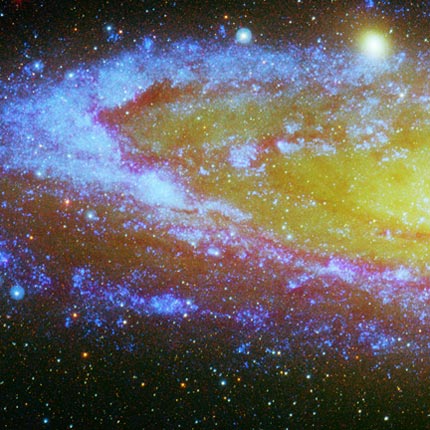
A starry neighbor:
This is a part of the Andromeda Galaxy, the closest big galaxy to our own Milky Way. This Spitzer image highlights the stars (rather than the dust) in this beautiful spiral galaxy.
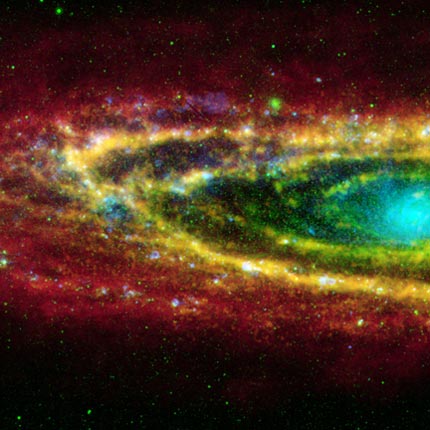
A dusty neighbor:
This is part of the Andromeda Galaxy, the closest big galaxy to our own Milky Way. This Spitzer image highlights the dust and gas (rather than the stars) in this beautiful spiral galaxy.
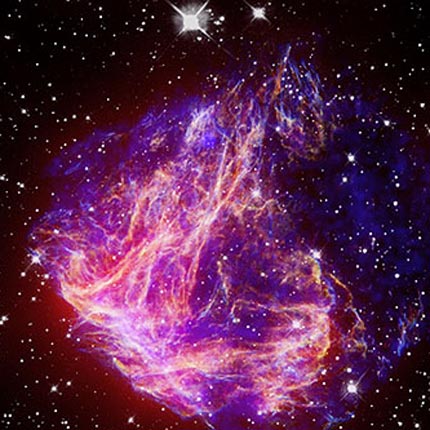
Seeing all the light:
This leftover remnant of gas and debris from a supernova explosion is called N49. This beautiful picture combines images from three different space telescopes, all seeing different kinds of light.
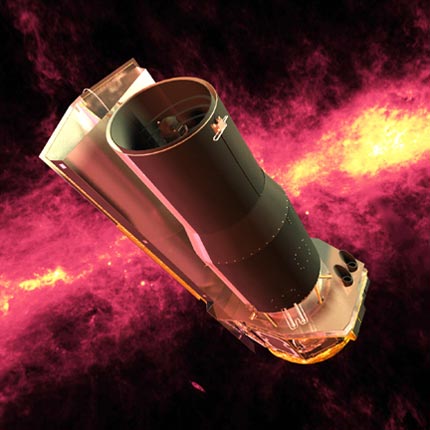
A Great Observatory:
The Spitzer Space Telescope was launched in 2003. It observes the universe in infrared light, which our eyes and ordinary telescopes cannot see. It has made many surprising discoveries so far.
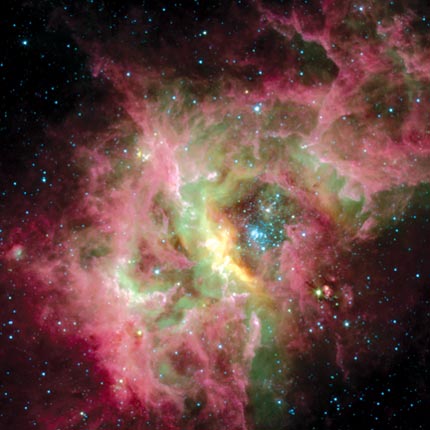
Stellar nursery:
This is a Spitzer Space Telescope image of the RCW 49 nebula. It is a cloud of dust and gas that contains hundreds of newborn stars. In all, more than 2,200 stars live in this nebula.
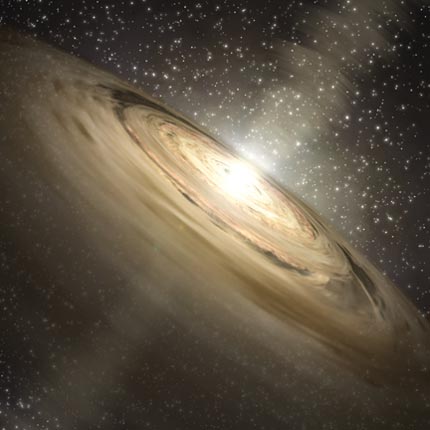
Young solar system:
This artwork shows how our own solar system might have looked before planets formed. Spitzer cannot make an image like this, but it can tell what ingredients are in the dust and gas around such stars.
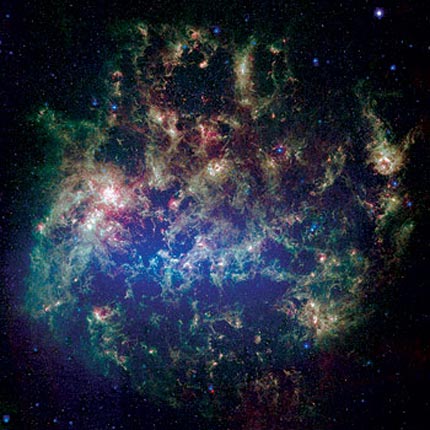
Dwarf galaxy:
This is a Spitzer image of the Large Magellanic Cloud, which, despite its name, is actually a dwarf galaxy that orbits our own Milky Way galaxy.
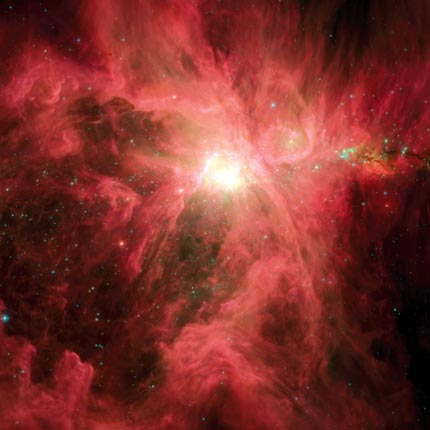
Planet nursery?
The Spitzer Space Telescope made this image of a dusty cloud called the Orion Nebula. Spitzer shows over 2,000 stars that have dusty disks around them. Each dusty disk could someday make planets and a whole other solar system.